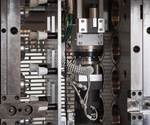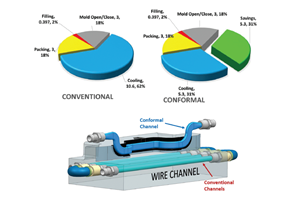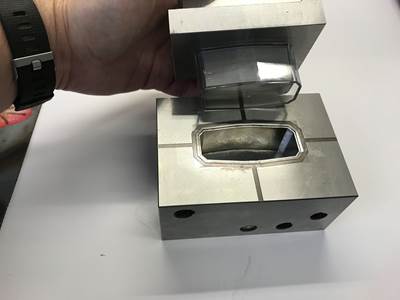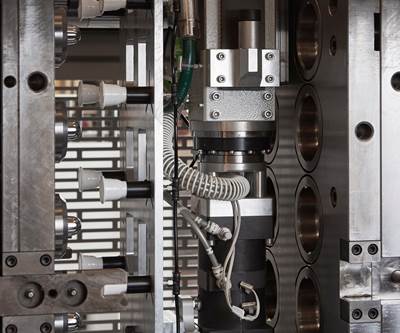Molding cycles are often determined by the last area on a plastic part to solidify, so special attention should be given to areas in the mold where it is difficult to deliver conventional cooling. While there are standard products designed to dissipate heat from challenging mold geometries—such as specialized mold metals and heat pipes — there may be situations where these options are unsuitable or additional cooling is necessary. Over the years, I have discovered several techniques to effectively cool those hard-to-reach hot spots.
Specialty Items for Mold Cooling
Beryllium copper alloys have been used for decades in core pins to transfer heat quickly. This material has largely been replaced with newer copper alloys that are less toxic, but still transfer heat well. They are softer than steel, limiting their use where greater strength or stiffness is required.
Cores made from some tungsten carbide alloys have greater stiffness and hardness than steel and transmit heat as well as copper alloys. However, they are much more difficult to grind and polish, increasing the manufacturing cost. Most tool shops will outsource them to manufacturers that specialize in these materials. While the initial mold cost may be higher, its longer life and reduced wear typically offset this by lowering maintenance costs over time.
Heat pipes were developed in the 1960s and found applications in plastic molding during the 1980s. These pipes are hollow-capped tubes filled with a liquid, such as alcohol or water. The liquid vaporizes at higher temperatures and then returns to a liquid at lower temperatures. This transfers heat energy much quicker than solid copper alloy rods.
They function most efficiently when positioned vertically, with the heat source (hot plastic) at the bottom and cooling at the top. If they are used in any other orientation, the heat pipe must have an internal wick to move the liquid against gravity to the cool end, but this reduces their efficiency.

The image above depicts a heat pipe. Source (all images) | DJC Plastic Consulting LLC
Additional Cooling Required
In some situations, more cooling is necessary, even with high heat transfer metals or in areas where these metals or heat pipes cannot be used. Using compressed air to cool hot spots is one solution. Filtered air may be necessary to avoid part contamination.
Typically, a flexible tube with a nozzle is mounted outside the mold, directing a jet of air onto the hot spot. Sometimes, a vortex cold air generator is used to cool the air. There are several issues with this approach: (1) Using compressed air to cool a small area consumes a significant amount of air, and producing compressed air is costly; (2) Much of the air is directed at parts of the mold that do not require additional cooling; (3) If the air is too cold, it can thermally shock the hot steel; and (4) Unless the air jets are rigidly and permanently mounted, the cooling effect can vary from one setup to another.
Options for Cooling with Compressed Air Through the Mold
(1) Channeling compressed air through the mold to precisely direct air onto the hot spots can provide the required targeted cooling and address these issues. The air channels can be drilled through mold plates and cavity or core blocks or milled onto the surfaces between mold plates. O-rings and other seals are typically unnecessary unless bridging large gaps, as most air will follow the channels even without a perfect seal. The air also picks up heat in the channel from the heated mold, preventing thermal shock.

This image is of a core pin air jet.
One of the simplest devices I have used is an air jet created from a core pin. The keyed core pin is installed with its tip extending above the parting line, positioned outside the mold cavity but close to the hot spot. The opposite half of the mold is clearance for this pin. The pin is drilled from the back, with a flat ground facing the hot spot and a small orifice drilled into the flat. If necessary, one pin can have multiple flats and orifices to cool a larger area.
For example, I once had to improve the cycle time, dimensional stability and appearance of a part made from PPSU. The mold temperature was about 300oF (150oC) and deep ribs could not get enough cooling from the circulating oil. The hot steel ribs caused sink with parts stuck on the ribs and ejector pins deformed the surface, resulting in excessive cycle time. A cooling air jet effectively spot-cooled the deep ribs in the mold between each shot, resolving all these issues.
(2) A core pin that is too small for a baffle or bubbler but large enough to enable a small hole to be EDM'd through it can effectively channel air through it for internal cooling. This pin should be designed to shut off against the other half of the mold.

Above image depicts a core pin – internal air cooled.
(3) A long, thin core pin that is enclosed by an ejector sleeve can trap excessive heat, making it difficult to cool. This challenge arises because the cooling channels are typically located far from the tip of the pin, and air gaps between the components further insulate it. This can lead to plastic buildup on the pin or cause distortion inside the hole it forms.
Cooling the pin by surrounding it with compressed air through a channel between the core pin and ejector sleeve can effectively prevent these issues. Cooling channels are cut between the ejector plates and into the head of the ejector sleeve. A slip-fit nylon bushing closes the gap between the ejector plate and the core pin, forcing air between the sleeve and the core pin. Grooves are cut into the inside of the sleeve to enable the air to flow. Holes are cut into the side wall of the sleeve at the end of each groove to enable air to flow even with the mold closed.

Ejector sleeve with air cooling and detailed views.
(4) Long, thin core pins on slide faces can also prove to be difficult to cool, even with liquid cooling channels in the slides. In this case, air channels can be cut into the mold steel between the mold plates leading to orifices positioned below the core pins when the slide is fully open. Compressed air is turned on as the mold opens and the slide retracts, blowing air onto the entire length of the pin’s molding surface.
For example, I've worked with clear nylon 11 parts that consistently had small bubbles on the inside diameter surface. This issue was resolved by remaking the slide core pins using a high heat transfer metal and cooling them with compressed air. I have also often observed that long, small-diameter slide core pins can turn dark blue due to overheating if they are not cooled with compressed air.

Air cooling slide core pins in forward and retracted positions.
It is important to look at each mold to see where hot spots may occur. Many times, the addition of a conventional liquid cooling bubbler or baffle will adequately address the problem. However, when it is difficult to cool conventionally, you may need an unconventional solution. The ideal time to address hot spots is during the design stage before mold steel is cut and parts are molded.
Related Content
How to Use Simulation to Achieve a High-Gloss Surface Finish
Combining simulation, conformal cooling, and a rapid heat and cooling process can predict and produce the required surface finish for high-gloss plastic parts.
Read MoreHow to Make Data Work for Mold Productivity and Performance
The use of digital workflows improves the impact of mold design libraries, conformal cooling and machine learning.
Read MoreAdvancing Moldmaking and Plastics: Trends in 3D Printing, Automation and Sustainability
NPE 2024 showcased the latest trends and technologies in innovation, efficiency and sustainability for moldmakers and molders, featuring advancements in 3D printing, automation, design and virtual reality/augmented reality/artificial intelligence.
Read MoreHow to Use Thermal Management to Improve Mold Cooling
A review of common mold cooling issues and possible solutions, including 3D printing applications.
Read MoreRead Next
How to Determine the Proper Vent Depth
Vent depth is critical to optimizing mold performance, so here is one approach to finding that elusive right number.
Read MoreStrategic Mold Cooling: Optimizing Molding Quality and Cycle Efficiency
Proper cooling is crucial in molding, yet often overlooked. Discover proper cooling methods to prevent defects and improve efficiency.
Read MoreStrategic Mold-Material Selection
In determining the right mold material, consider part finish, production volume, part material, cycle time and mold details like molding resin.
Read More




















